 Yet another “duel” version of a game? I know, I know. My first thought upon hearing about Azul Duel was “But the game is already great with two players!” Still, curiosity got the better of me, and here we are.
Yet another “duel” version of a game? I know, I know. My first thought upon hearing about Azul Duel was “But the game is already great with two players!” Still, curiosity got the better of me, and here we are.
Azul Duel pits two players against each other to create the aesthetically pleasing ceiling in the Palace of Sintra. Play time is about 30-45 minutes.
Gameplay Overview:
On their turns, players can draft circular tiles from one of five “factories”. When drafting, you take all of the tiles of one color from a factory, then any leftover tiles remain on the factory but get stacked over a special bonus chip. On a future turn, players can opt to take every tile of the same color from the tops of each of these leftover tile stacks. When the last tile is taken from a stack, the bonus token at the bottom is revealed, which players may later choose to take on their turn. Bonus tokens can be spent to substitute in as a tile of the matching color during the scoring phase.
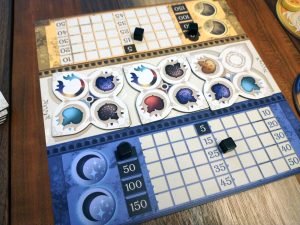
Each of the player boards has two sections: the left side with rows of spaces for placing the tiles you take, in ascending quantity—the top row has one space, next has two spaces, and so on until the bottom, which has six spaces. At the end of the round, players will move the last tile from any full row to a matching color space on the right side of their board. They score points according to the number of contiguous tiles in the same column and/or row.
The right side of the board is a grid which is empty to begin with, but will be filled with “dome plates” as players draft them each round. Three are placed face-up and can be taken for free, or players may lose a point (you begin the game with five points) in order to draw one from the facedown stack. Each dome plate has spaces to hold four tiles of specific colors, in addition to either a wild space to hold any color, or a special tile space, which is only filled after every other space of that dome plate is filled.
Players score at the end of each round, possibly losing points for tiles they could not place, then the factories are refilled with tiles and bonus chips. The game ends after the fifth round and, in addition to points gained during the game, points are scored according to three variable end-game conditions to determine the winner.
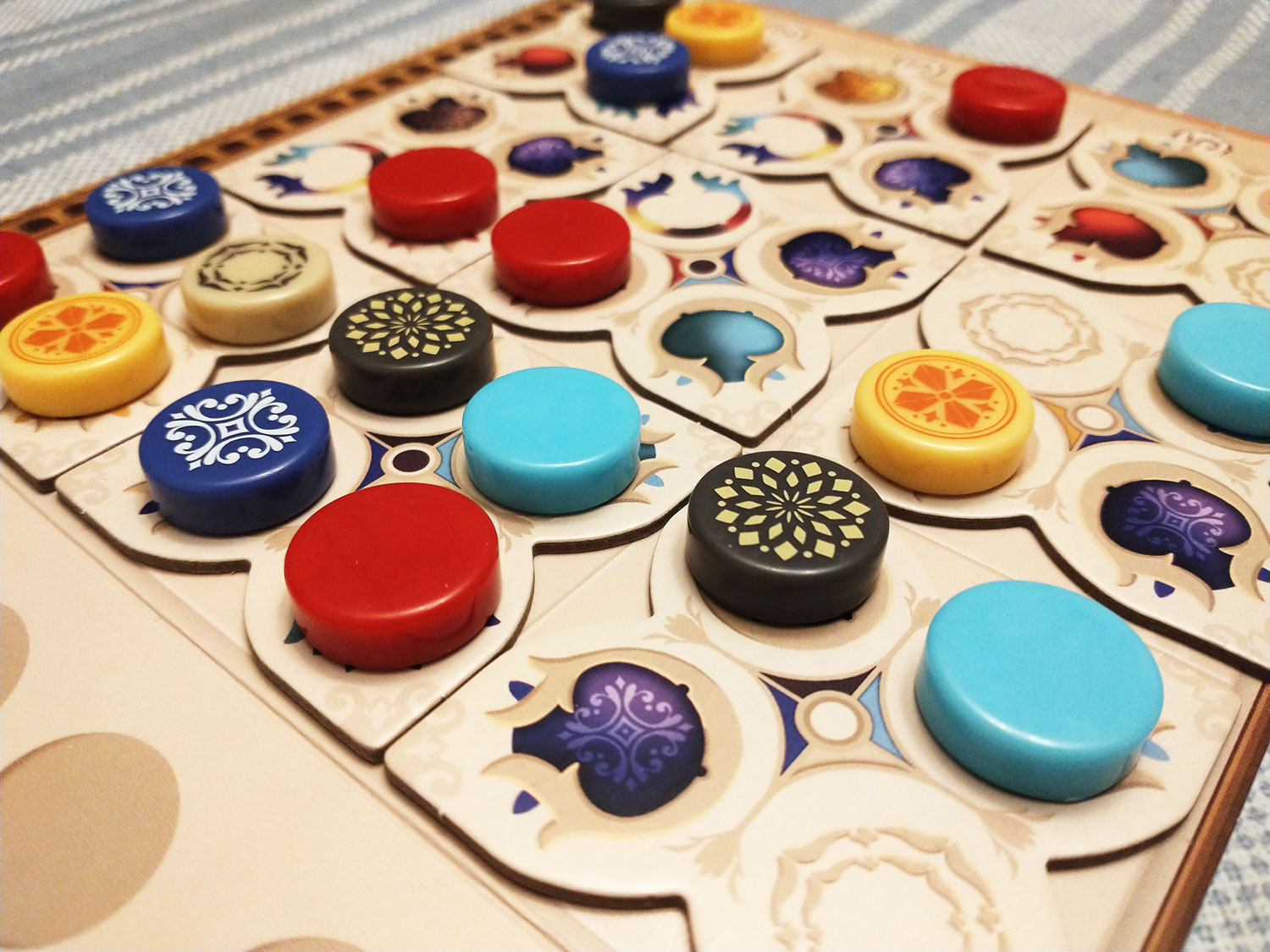
Gameplay Experience:
This is where I might be expected to say the game is convoluted and muddies up the clean and streamlined gameplay of the original Azul. I could say that, except I won’t because I sort of love this game. I don’t think it’s attempting to replace Azul on anybody’s shelf, but rather that it should be thought of as simply another version of the game, like Stained Glass of Sintra or Summer Pavilion. It’s not that it’s better, it’s not that it’s worse, it’s just another option. And I would venture to say, one I might choose over the original when it comes to two player games. It’s as if the designer, Michael Kiesling, thought, “What if we tried this…oh, and this!” then went for it and came up with something rather fascinating.
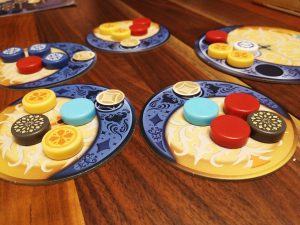
With a few exceptions at the end of rounds, I feel like absolutely every action you take matters. The game has a fantastic sense of tension because there is more at stake than simply the tiles on the factories (but those definitely do matter)—you’re also worried about getting the dome plate you need as well as losing a point if you need to draw from the facedown stack. Building the grid upon which you’re placing your tiles is a neat twist that gives players control over their own board.
The bonus tokens, which can be spent to replace a tile, are also a nice addition. It can be so frustrating to just be one tile away from filling a row at the end of the round, but if you spend two matching bonus tokens (or any three non-matching), you can count them as one of the tiles of the needed color. There are also special spaces that score a set amount of points based on which row they’re in when you’ve covered the other three spaces on the dome plate, and wild spaces that can be filled with any tile. These features add another dimension to gameplay so that nothing feels too limiting, although there will still be the occasional round where the colors you want simply aren’t drawn from the bag.
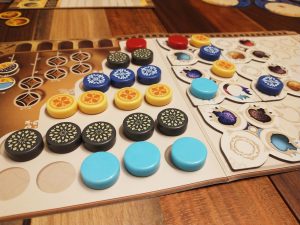
The game moves at a good back-and-forth pace with the occasional moments of consideration. The listed play time is forty-five minutes, but I believe it is easily playable in thirty. Something else I’m a huge fan of is that the game ends after five rounds. I know this is a personal preference, but one of my least favorite things about Azul is that players trigger the end, so I always feel torn between enjoying the game and taking more turns, or doing the strategically smart thing and ending the game when I’m ahead. I much prefer tAzul Duel’s fixed end condition, as well as how the scoring conditions differ, if only slightly, from game to game.
Final Thoughts:
I can certainly understand some preferring the cleaner, smoother experience of the original Azul, but for me, the original can start to feel a little samey after so many plays. Azul Duel changes it up by adding variety and complexity. The more I played it the more I liked it, to the point that I think I would prefer to play this with specifically two over the original.
I like that there is more to think about than just which color of tiles you want. Every new little twist adds to the tension that we look for in two-player games, without feeling overly mean. Did we ask for a two-player version of Azul? No. Did we need one? No. Does it still manage to be a great game in its own right? Absolutely! And whether you love Azul or have never played any version of it, if you approach this game with an open mind it might just surprise you.
Final Rating: 4 stars – This creative take on a modern classic results in a tense and exciting duel for two!
 Hits:
Hits:
• End condition and variable scoring
• Tension without (too much) direct meanness
• Adds complexity for those who want it
Misses:
• Not as streamlined as the original
• Might feel unnecessarily complicated to some



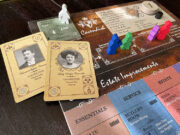

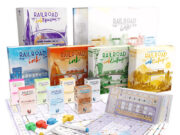















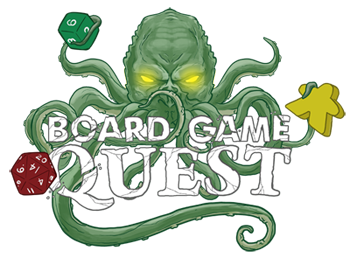
Very nice review! I’ve played many games of base Azul and Summer Pavilion, and have been curious about this. Shelf space is at a premium these days, and already having a copy of Azul, I figured this would be redundant. Sounds like I was wrong based on your comments.
One question: is this version more travel-friendly than the base Azul game? The box is too big for that one to travel with. Does this one come more compact?
Hi James, thanks for the comment. Yes, this edition comes in a smaller box- the 8″ x 2″ size that seems to be standard for many two player games, so it’d be easier to travel with. It’s also available on BGA if you’re interested it trying it out.